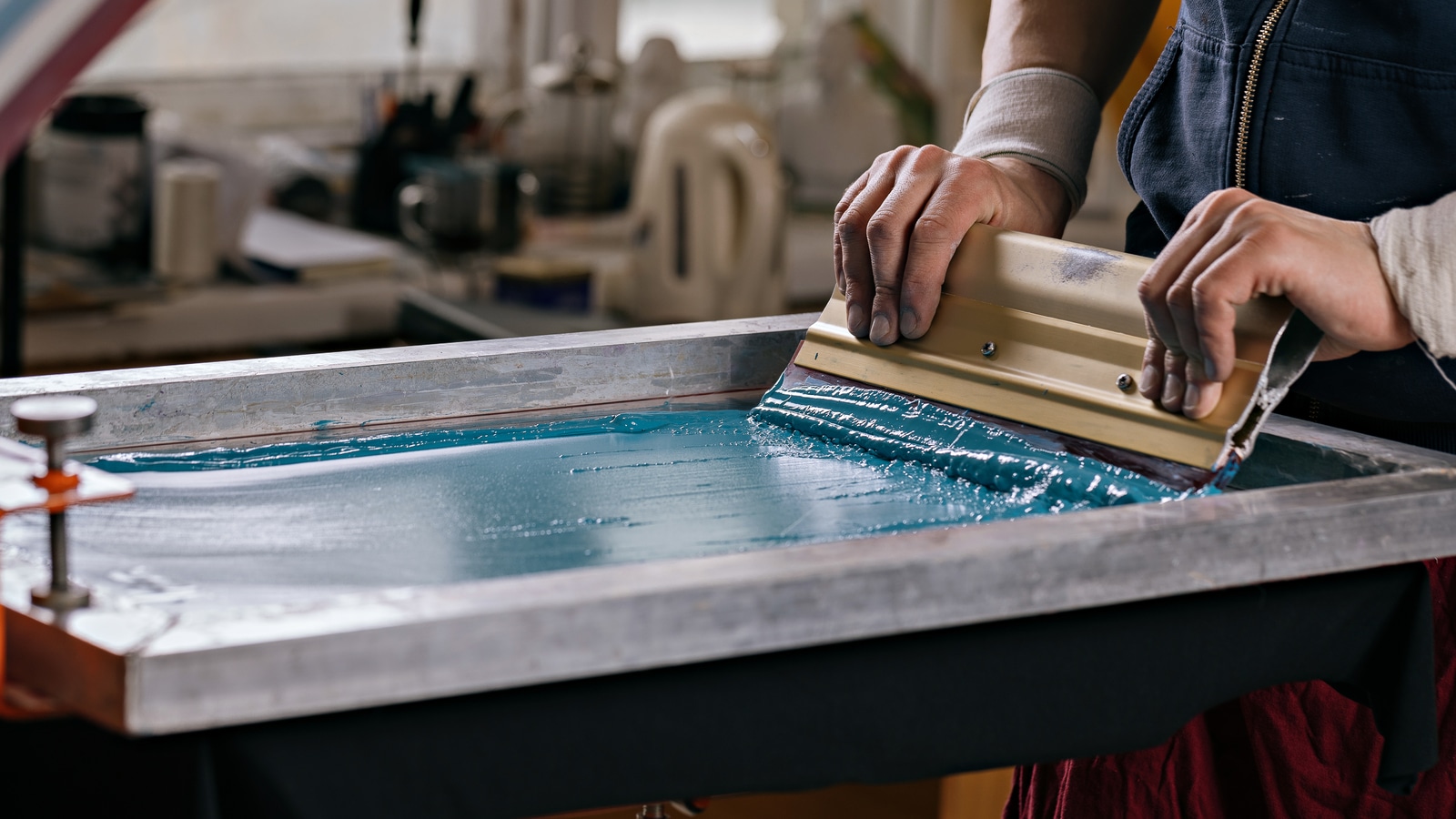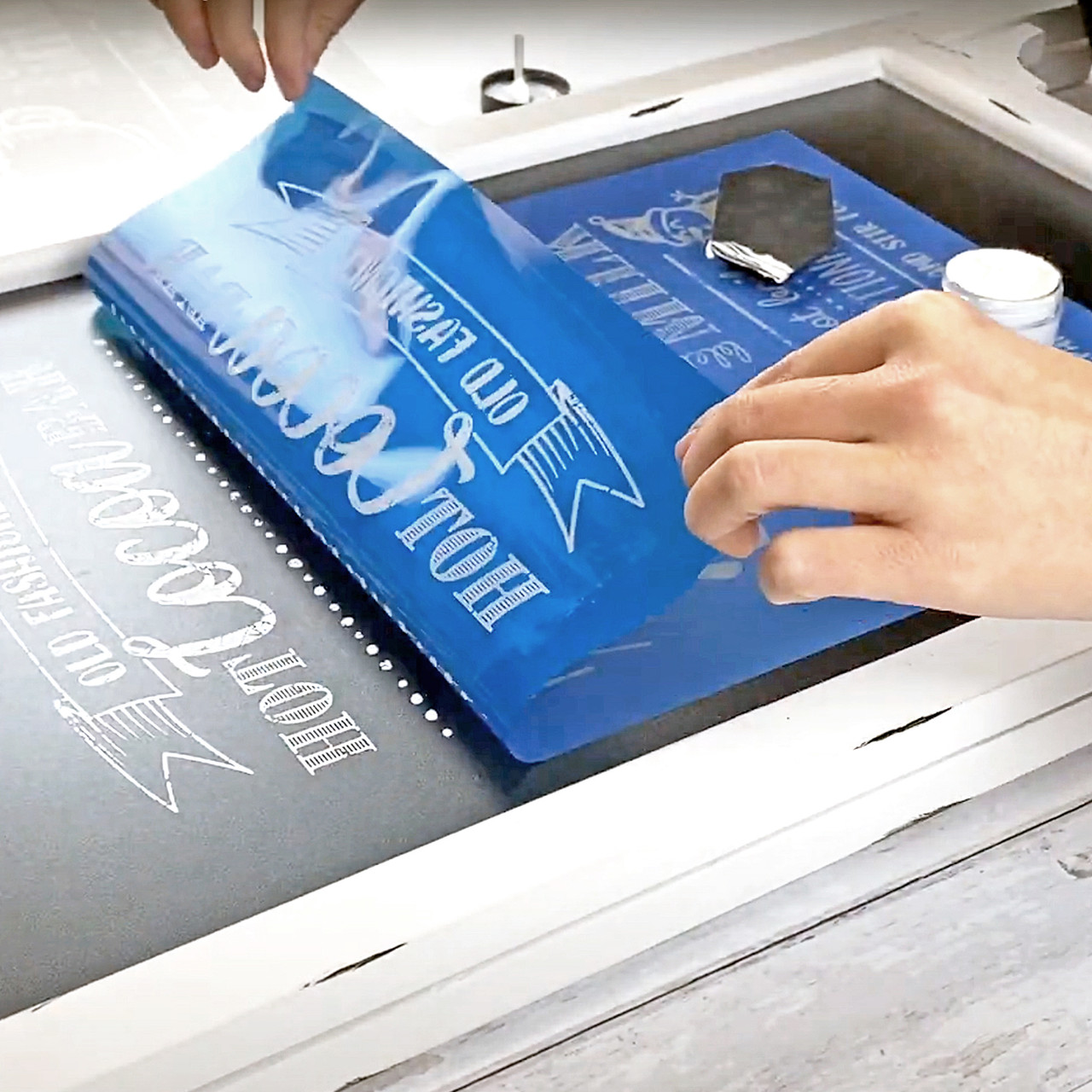Premium Screen Printing Kit for Business Startups
Premium Screen Printing Kit for Business Startups
Blog Article
Screen Printing Uncovered: Whatever You Required to Learn About Tee Shirt and Garment Printing Strategies
Display printing is a remarkable approach that integrates art with method, supplying endless opportunities for imagination. Prepared to explore the necessary components that make screen publishing an art type?
The Fundamentals of Screen Printing: How It Functions
When you plunge right into display printing, you'll find it's both a science and an art. At its core, display printing involves developing a stencil, or screen, that permits ink to pass via only in certain areas.
Position the screen over the fabric, after that utilize a squeegee to push ink via the screen onto the garment. Each action is necessary, and mastering them will boost your screen printing abilities, changing basic garments right into distinct, meaningful items.
Kinds of Display Printing Methods
Once you grasp the basics of screen printing, it's time to explore the numerous strategies that can elevate your styles. One prominent method is conventional screen printing, where ink is pressed via a stenciled display.
Another alternative is plastisol printing, understood for its toughness and dazzling colors, making it a favored for lots of brands. Experiment with halftone printing to develop slope effects and detailed styles.
Vital Equipment for Display Printing
To achieve magnificent cause screen printing, having the ideal equipment is essential. First, you'll require a durable display printing frame, which holds the mesh that transfers your style onto the garment. Next off, spend in premium mops; these are important for using ink evenly across the screen. You'll likewise call for a great exposure unit to develop your screens, along with a washout cubicle for cleansing them after use. A reputable warmth source, like a conveyor clothes dryer or heat press, is vital for healing your prints to ensure durability. Do not fail to remember a proper work space, furnished with tables and storage space for your supplies. Safety gear, such as masks and gloves, will keep you safe from chemicals and inks. With the right tools, you'll be well on your method to producing professional-quality prints.
Picking the Right Inks and Products
When selecting inks and materials for screen printing, you need to take right into account the sort of ink that functions ideal for your job. Think about material compatibility to ensure your layouts look last and great lengthy. Check out environment-friendly ink alternatives to make your printing process extra lasting.
Types of Display Inks
Picking the best screen ink is important for achieving lively, resilient prints that fulfill your project's demands. There are numerous types of screen inks to take a look at. Specialty inks, such as metal or glow-in-the-dark, can add distinct impacts to your layouts.

Fabric Compatibility Considerations
Comprehending textile compatibility is crucial for attaining high-quality display prints, particularly considering that different products react distinctively to various inks. When choosing inks, consider the material type-- cotton, polyester, or blends. For cotton, water-based inks function well, supplying softness and breathability. Polyester, on the various other hand, usually needs plastisol inks for much better bond and vivid shades. You might require to utilize a mix of both types if you're printing on blends. Constantly examine your inks on sample fabric to assure they adhere correctly and maintain color honesty. Furthermore, maintain in mind that fabric weight and texture can affect the final end result, so choosing the right ink and product combination is important for your job's success.
Eco-Friendly Ink Options
Eco-friendly inks are becoming a prominent option for screen printers that want to decrease their environmental effect while preserving quality. When selecting inks, take into consideration water-based inks, which are less dangerous and less complicated to cleanse up contrasted to conventional solvents.
Additionally, try to find inks made from renewable energies, such as soy or vegetable-based options. By choosing the best inks and materials, you'll not only produce magnificent styles however also contribute to a more lasting printing procedure. Make the button, and your prints will certainly reflect your commitment to the atmosphere!
Preparing Your Design for Screen Printing

Submit Style Requirements
To guarantee your style looks vivid and sharp on fabric, you'll need to pay close interest to file style demands for screen printing. Make certain your design has a clear background to protect against unwanted white edges on your prints. Maintain shade settings in mind; CMYK is standard for screen printing, so transform your RGB designs accordingly.
Color Splitting Up Strategies
Color separation is an important action in preparing your style for display printing, and mastering it can greatly enhance your print quality. You'll need to break your style right into private shades, as each shade needs a different display throughout printing. Begin by determining all the shades in your style and create layers for each one. You can utilize software application like Adobe Photoshop or Illustrator to separate and separate colors successfully. Be certain to conserve each layer as a separate data, usually in a format like TIFF or PSD. This precision not only guarantees precise color representation however also streamlines the printing procedure. By focusing on shade splitting up, you'll accomplish professional and lively results in your screen-printed garments.
Resolution and Dimension
Achieving the best outcomes in screen printing begins with ensuring your style has the right resolution and size. Ideally, your artwork should go to the very least 300 DPI (dots per inch) for sharp, clear prints. If you make use of reduced resolution, your end product might look unprofessional and pixelated.
When it comes to dimension, consider the dimensions navigate here of your print location. Layout your art work to match the final print dimension, ideally developing it in the actual dimensions you'll be printing. This means, you'll prevent any kind of unexpected scaling problems.
Always inspect your design in both vector and raster layouts. Vector graphics can be scaled without shedding high quality, making them ideal for display printing. Preparing correctly will guarantee your layout looks outstanding on every garment!
Step-by-Step Screen Printing Process
Screen printing is a dynamic procedure that allows you to develop lively styles on various surfaces. To get started, you'll require a display, solution, and your chosen ink.
After rinsing the unexposed solution, your screen is all set. Set it up on your printing surface and align your garment under it. Put ink onto the display and utilize a squeegee to push the ink via the pattern onto the material. Lift the screen meticulously and allow the print completely dry. Finally, heal the ink making use of heat to guarantee durability. That's it! You have actually effectively screen printed your layout.
Tips for Effective Screen Printing Projects
While you're diving right into your display printing projects, keep in mind that preparation is essential to success. Begin by collecting all your materials-- inks, mops, screens, and garments. A clean work space assists avoid undesirable errors, so clean up prior to you start.
Next, confirm your art work is high-resolution and effectively sized for your garment. Check your screen for appropriate exposure and clean it thoroughly to stay clear of spots. When blending your inks, comply with the producer's guidelines to attain the ideal consistency.
Throughout printing, use even pressure with your squeegee for regular results. Don't rush; take your time to confirm each print meets your requirements. After printing, let your garments completely dry completely before handling or packaging them.
Finally, constantly maintain a sample of your benefit future recommendation. This way, you can examine your progress and boost your strategies gradually. Happy printing!

Regularly Asked Inquiries
Just how Long Does It Take to Set up a Display Printing Job?
Establishing a screen printing job commonly takes around 30 minutes to an hour. You'll prepare the check my source displays, mix inks, and readjust journalism. The moment differs based upon complexity and experience, so remain arranged!
Can I Publish on Various Textile Keys In Making Use Of the Very Same Method?
Yes, you can publish on different textile kinds utilizing the same method, however you'll require to adjust your settings and inks. Some fabrics take in ink differently, so experimenting guarantees the ideal results for each product.
What Are Usual Mistakes to Prevent in Screen Printing?
When display printing, prevent common mistakes like utilizing the incorrect ink, overlooking appropriate direct exposure times, or missing pre-press checks. Always evaluate your configuration and maintain tidy screens to ensure top quality results each time.
Just How Can I Properly Clean and Maintain My Screen Printing Devices?
To correctly clean and preserve your screen printing equipment, you need to regularly wash screens with appropriate solvents, inspect mops for wear, and ensure all tools are saved dust-free and completely dry. Consistency boosts and prevents costly fixings efficiency.
Is Display Printing Eco-friendly Compared to Various Other Methods?
Display printing can be a lot more environmentally friendly than various other methods, especially if you make use of water-based inks and eco-conscious materials. By selecting lasting products and methods, you decrease waste and minimize your influence on the earth.
Screen Printing Uncovered: Every Little Thing You Required to Know About Tee Shirt and Garment Printing Methods
At its core, screen printing includes producing a stencil, or screen, that enables ink to pass with only in specific areas. Placement the display over the material, then utilize a squeegee to press ink via the screen onto the garment. One preferred technique is traditional screen printing, where ink is pushed through a stenciled display.When selecting inks and products for display printing, you require to take into account the type of ink that works best for visit site your project.
Report this page